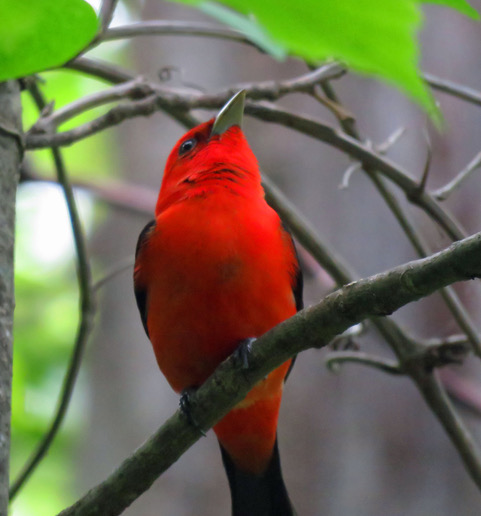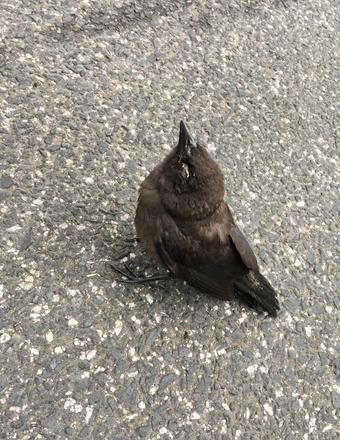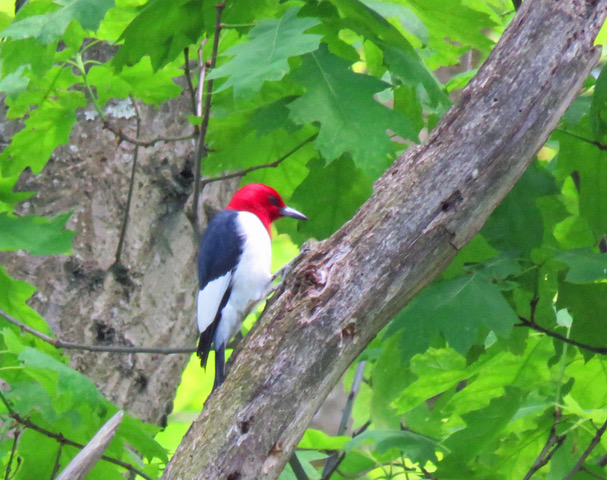Scientists Urge People to Stop Feeding the Birds –
“Man has lost the capacity to foresee and to forestall. He will end by destroying the earth.”
— Albert Schweitzer

A rare, scarlet tanager flew across the trail in front of me in Shenandoah National Park, and landed just long enough to get this one shot: Glynn Wilson
By Glynn Wilson –
CATOCTIN MOUNTAIN, Md. — In 1962, before President John F. Kennedy was shot and killed in Dallas, he set up a special science advisory panel to study the problem of chemical pesticides after reading Rachel Carson’s book Silent Spring. She dedicated the book to Albert Schweitzer.
In the introduction, she wrote of a “Fable for Tomorrow” and a “strange blight” that had crept over the land, in the form of a white powder called DDT that was being sprayed all over the country to kill mosquitoes.
“There was a strange stillness. The birds, for example — where had they gone? Many people spoke of them, puzzled and disturbed. The feeding stations in the backyards were deserted. The few birds seen anywhere were moribund; they trembled violently and could not fly. It was a spring without voices. On the mornings that had once throbbed with the dawn chorus of robins, catbirds, doves, jays, wrens, and scores of other bird voices there was now no sound; only silence lay over the fields and woods and marsh.”
It took a decade, but DDT was banned in the United States in 1972, and in recent years, scientists have reported a strong return of the bald eagle and other birds.
Related: American Bald Eagle Population Soars Back From Near Extinction
Another Blight Killing Birds in DC
Another blight seems to be killing the birds in the D.C. Metro Area, now living under the once in a 17-year hum of the Brood X cicadas — first written about by William Bartram in 1732 in Philadelphia before the Unites States won its independence from Great Britain.
Could this new blight be due to the birds eating the cicadas that have been waiting under pesticide soaked ground for 17 years to come out again to breed? That was the suggestion of one scientists interviewed on WAMU, the NPR radio station in Washington.
Reports of blind and dead birds have been coming in from southern Maryland, the District of Columbia and across Northern Virginia into the West Virginia Panhandle since May, according to a recent report from the U.S. Geological Survey, which is now urging people to stop filling bird feeders and bird baths in case the cause is a communicable disease.

This bird was found in the Washington, D.C. metro region with swollen eyes and crusty discharge, a sign observed on most birds affected by a May/June 2021 mortality event in the area: Leslie Frattaroli, NPS
“Birds congregating at feeders and baths can transmit disease to one another,” the agency said.
Therefore, the state and District agencies recommend that the public in the outbreak area:
* Cease feeding birds until this wildlife mortality event has concluded.
* Clean feeders and bird baths with a 10 percent bleach solution.
* Avoid handling birds, but wear disposable gloves if handling is necessary.
* Keep pets away from sick or dead birds as a standard precaution.
“If you encounter sick or dead birds, please contact your state or District wildlife conservation agency. If you must remove dead birds, place them in a sealable plastic bag to dispose with household trash,” the agency says. “Additional information will be shared as diagnostic results are received.”
Area residents have described finding birds whose eyes are swollen, encrusted or oozing discharges. Some show neurological symptoms: They have tremors, hold their heads at a tilt or have trouble balancing and walking, according to reporting by the Washington Post.
“This is significant because it seems to be pretty widespread, and also it’s extending for a pretty good period of time. And it’s continuing,” said Megan Kirchgessner, a veterinarian with Virginia’s Department of Wildlife Resources, who said at least 325 reports of ailing birds have been collected. She said the ailment appears to be confined only to birds, not other animals, and to fledglings of two species, grackles and blue jays.
There is no evidence yet that the ailment is transmissible to humans or other animals, and the cause is being investigated, but there have been reports of sick dogs known to be eating the cicadas.
Scientists at a number of laboratories, including the USGS National Wildlife Health Center, the University of Georgia’s Southeastern Cooperative Wildlife Disease Study and the University of Pennsylvania’s Wildlife Futures Program, have been trying to determine the cause of the ailment.
Kirchgessner said it’s always better to let birds and animals find their own food because of the possibility of spreading disease.
“From a veterinary perspective, especially in the springtime when food is abundant, there’s no reason for those feeders to be out,” she said. “And to be perfectly honest, especially in a situation like this, they can do more harm than good.”
Experts on pesticide use say chemicals are often over used and can harm animals, including birds.
“Many of the insecticides used on trees can persist for a long time, putting wildlife at risk,” said AImee Code, pesticide program director at the Xerces Society for Invertebrate Conservation. “We may not have a smoking gun, but we still need to heed these warnings and change how we manage our landscapes. That includes stopping the heavy pesticide use that has become so common place.“
New Report on Birds Impacted by Climate Change
Meanwhile, the U.S. Fish and Wildlife Service has just released a new report on bird conservation that takes into account how human impacts on North American birds will intensify with ongoing climate change.
The new report identifies 269 species of conservation concern, including the snowy owl, red-headed woodpecker, American white pelican and Vaux’s swift. Species of concern include 54 percent of grassland birds, 53 percent of shorebirds and 48 percent of seabirds.
Last issued in 2008, “Birds of Conservation Concern 2021” is meant to serve as an “early warning system” to help federal agencies focus on species that may warrant protection under the Endangered Species Act.
“This report reinforces the growing scientific alarm that birds across North America are falling victim to the extinction crisis in greater and greater numbers,” said Noah Greenwald, endangered species director at the Center for Biological Diversity. “Long the leading cause of bird declines, habitat destruction is being worsened by climate change. We hope this report signals a commitment from the Biden administration to quickly protect more of the natural world, so these birds can continue to grace our skies.”
The biggest increase in newly imperiled species identified since the 2008 report is among birds found in Hawaiʻi and the Pacific Islands: 35 species, up from 23 in 2008. This increase is striking because most Hawaiian birds are already listed as threatened or endangered under the Endangered Species Act. Those listed species are not included in the report.
A sobering 2019 study by the Cornell Lab of Ornithology found that the North American population of breeding adult birds has decreased by a staggering 2.9 billion individuals since 1970.
The Trump administration sought to redefine and drastically weaken the scope of the Migratory Bird Treaty Act. One of the nation’s first conservation laws, the Act was enacted to implement U.S. international treaty commitments to protect populations of migratory birds.
In May the U.S. Fish and Wildlife Service released a proposal to revoke a final Trump administration rule that sought to modify the Act. The Center and other national environmental groups filed suit in January challenging the Trump administration’s reinterpretation of the law, and are urging the Biden administration to reverse it.
That pressure appears to be working.
Related: Biden Administration Brings Back Endangered Species Protections Gutted Under Trump














